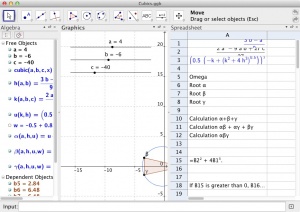Cubics: Difference between revisions
SimonKnight (talk | contribs) No edit summary |
TonyHoughton (talk | contribs) No edit summary |
||
| (4 intermediate revisions by 2 users not shown) | |||
| Line 2: | Line 2: | ||
{{DISPLAYTITLE:Cubic Equations and Their Roots}} | {{DISPLAYTITLE:Cubic Equations and Their Roots}} | ||
{{Rinfo | {{Rinfo | ||
|type= Lesson idea | |||
|attribution={{Tony Houghton}} | |||
|title=Cubic Equations and Their Roots | |title=Cubic Equations and Their Roots | ||
|tagline= | |tagline=To interactiviley explore and understand complex mathematics with GeoGebra | ||
|image=Cubics.jpg | |image=Cubics.jpg | ||
|topic=Statistics | |topic=Statistics | ||
|subject=Maths | |subject=Maths | ||
|resourcenumber= M0031 | |resourcenumber= M0031 | ||
|age= | |age= KS4, KS3, Secondary | ||
|content= This activity is explore cubic equations and their complex roots, to use Geogebra to find the solution to any cubic equation, given its coefficients, and plot the real and complex roots on an Argand diagram so that as the user changed the coefficients, they could see how that affected the roots of the cubic equation. | |content= This activity is explore cubic equations and their complex roots, to use Geogebra to find the solution to any cubic equation, given its coefficients, and plot the real and complex roots on an Argand diagram so that as the user changed the coefficients, they could see how that affected the roots of the cubic equation. | ||
| Line 20: | Line 23: | ||
|format= wiki page with downloadable .doc version | |format= wiki page with downloadable .doc version | ||
|related resources=This activity was a result of the [[GeoGebraSTEM exploration day]] umbrella activity which asked students to develop 'real world' GeoGebra mathematical modeling applications which reach out to a wide range of users both students and teachers. It is described in their own words. | |related resources=This activity was a result of the [[GeoGebraSTEM exploration day]] umbrella activity which asked students to develop 'real world' GeoGebra mathematical modeling applications which reach out to a wide range of users both students and teachers. It is described in their own words. | ||
|resources=This is the accompanying GeoGebra application: | |resources=This is the accompanying documentation and GeoGebra application: | ||
*[[file:Cubic.ggb]] | *[[file:Cubic roots.docx]] | ||
*[[file:Cubics.ggb]] | |||
}} | }} | ||
Latest revision as of 15:12, 15 January 2013
Lesson idea. This activity is explore cubic equations and their complex roots, to use Geogebra to find the solution to any cubic equation, given its coefficients, and plot the real and complex roots on an Argand diagram so that as the user changed the coefficients, they could see how that affected the roots of the cubic equation.
The potential age group is for Lower 6th students who are interested and want to learn something outside of their syllabus, and for Upper 6th students for whom it may be relevant to their studies on complex numbers and the relationships between roots of equations. I think my project would appeal to them as it is expanding on the syllabus that is taught
Teaching approach. This lesson features a ‘real life’ example for students to explore using visualisation(ta) via GeoGebra. The focus on ‘real life’ increases student motivation.
The activity engages pupils in group talk(ta), mathematical thinking(ta) and vocabulary(ta). This open ended(ta) task encourages higher order(ta) thinking, and encourages whole class(ta) discussion(ta)/questioning(ta) and inquiry(ta) projects. (edit)
| Resource details | |
| Title | Cubic Equations and Their Roots |
| Topic | [[Topics/Statistics|Statistics]] |
| Teaching approach | [[Teaching Approaches/Group talk|Group talk]], [[Teaching Approaches/Open ended|Open ended]], [[Teaching Approaches/Higher order|Higher order]], [[Teaching Approaches/Questioning|Questioning]], [[Teaching Approaches/Whole class|Whole class]], [[Teaching Approaches/Mathematical thinking|Mathematical thinking]], [[Teaching Approaches/Language|Language]], [[Teaching Approaches/Visualisation|Visualisation]], [[Teaching Approaches/Inquiry|Inquiry]], [[Teaching Approaches/Discussion|Discussion]] |
| Learning Objectives | By the end of the activity students should be able to understand how a mathematical software modelling and visualisation tool such as GeoGebra can be used to explore 'real life' mathematics. |
| Format / structure | wiki page with downloadable .doc version |
| Subject | [[Resources/Maths|Maths]] |
| Age of students / grade | [[Resources/Secondary|Secondary]], [[Resources/KS4|KS4]], [[Resources/KS3|KS3]]
|
| Related ORBIT Wiki Resources | This activity was a result of the GeoGebraSTEM exploration day umbrella activity which asked students to develop 'real world' GeoGebra mathematical modeling applications which reach out to a wide range of users both students and teachers. It is described in their own words. |
| Files and resources to view and download | This is the accompanying documentation and GeoGebra application:
|

